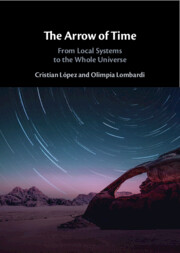
- Publisher:
- Cambridge University Press
- Online publication date:
- October 2025
- Print publication year:
- 2025
- Online ISBN:
- 9781009581608

The 'arrow of time,' a concept first introduced by Sir Arthur Eddington, reflects the one-way flow of time and its association with various physical asymmetries in thermodynamics, cosmology, quantum mechanics, field theories, and beyond. Yet, the foundations of the arrow of time continues to challenge physicists and philosophers, having profound implications across multiple theories and disciplines.This volume compiles insights from the international colloquium 'The Arrow of Time: From Local Systems to the Whole Univers' held in Buenos Aires in 2023. It explores diverse perspectives on the arrow of time in thermodynamics, quantum mechanics and cosmology, its relation to counterfactual reasoning, free will and the growing-block universe, the interplay between consciousness and time, and the implications of time-reversal invariance. Collectively, these contributions provide a rigorous and comprehensive analysis of the enduring enigma of time's unidirectional nature.
 Loading metrics...
Loading metrics...
* Views captured on Cambridge Core between #date#. This data will be updated every 24 hours.
Usage data cannot currently be displayed.
This section outlines the accessibility features of this content - including support for screen readers, full keyboard navigation and high-contrast display options. This may not be relevant for you.
The PDF of this book complies with version 2.1 of the Web Content Accessibility Guidelines (WCAG), covering newer accessibility requirements and improved user experiences and achieves the intermediate (AA) level of WCAG compliance, covering a wider range of accessibility requirements.
Allows you to navigate directly to chapters, sections, or non‐text items through a linked table of contents, reducing the need for extensive scrolling.
Provides an interactive index, letting you go straight to where a term or subject appears in the text without manual searching.
You will encounter all content (including footnotes, captions, etc.) in a clear, sequential flow, making it easier to follow with assistive tools like screen readers.
You get concise descriptions (for images, charts, or media clips), ensuring you do not miss crucial information when visual or audio elements are not accessible.
You will still understand key ideas or prompts without relying solely on colour, which is especially helpful if you have colour vision deficiencies.
You gain clarity from ARIA (Accessible Rich Internet Applications) roles and attributes, as they help assistive technologies interpret how each part of the content functions.